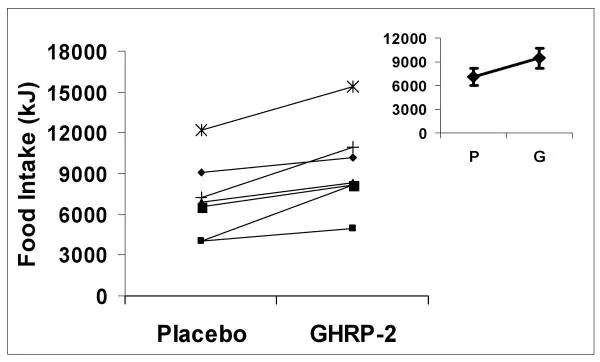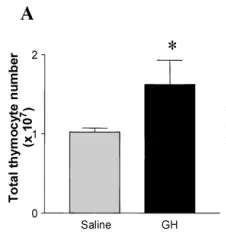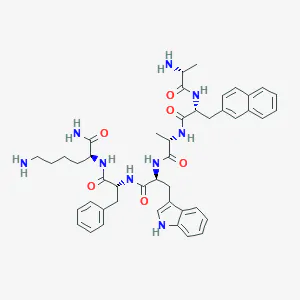1. Protects and Enhances Muscle Structure
GHRP-2 has been studied for its potential to protect and enhance muscle structure. According to the search results, GHRP-2 administration has shown significant enhancement of myofiber diameter and area in skeletal muscle. It is believed that GHRP-2 can stimulate protein synthesis, which may contribute to muscle growth and maintenance.
In addition to its effects on muscle structure, GHRP-2 has been reported to enhance flexibility in joint health, and promote better recovery from injuries. By stimulating the release of growth hormone, GHRP-2 may support muscle repair and regeneration, leading to improved muscle structure.
2. Stimulates Appetite
According to the search results, GHRP-2 is able to stimulate appetite. It is believed that GHRP-2 stimulates the release of ghrelin, a hormone known to regulate hunger and appetite. Animal studies have shown that GHRP-2 can increase food intake when administered. Additionally, individuals using GHRP-2 may experience increased appetite as a common side effect.

Food intake in healthy adult men, placebo versus GHRP-2
Source: PubMed
3. May Protect the Heart
This peptide has shown potential for protecting the heart. Studies have indicated that pretreatment with GHRP-2 can selectively protect against diastolic dysfunction of myocardial stunning. GHRP-2 pretreatment has also been found to protect against diastolic myocardial dysfunction induced by temporary ischemia and reperfusion.
In addition, GHRP-2 has demonstrated positive effects on cardiac function. It has been reported to improve cardiac dysfunction and alleviate the development of cardiac cachexia. Some studies suggest that GHRP-2 exhibits protective activity against cardiac ischemia in the hearts of growth hormone-deficient rats.
4. Improves the Immune System
GHRP-2 displays potential benefits in improving the immune system. It is believed to enhance immune response and reduce inflammation. Studies have shown that GHRP-2 administration can lead to a decrease in serum IL-6 levels and improved inflammation. Additionally, GHRP-2 has been found to stimulate immune cells through ghrelin receptors, exhibiting anti-inflammatory effects.
Improving the immune system by GHRP-2 can contribute to a healthier immune response and overall immune function. The peptide may support the body in mounting an appropriate immune response when faced with pathogens or foreign substances.
Furthermore, GHRP-2 may help protect neurons and support the central nervous system. This can indirectly influence the immune system since proper neurological functioning is essential for immune regulation and defense mechanisms.

Change in number of active T-cells following administration of GHRP-2
Source: PubMed
5. Improves Sleep Quality
Studies have indicated that GHRP-2 administration may positively impact sleep patterns and promote better sleep. It has been observed that GHRP-2 can enhance slow-wave sleep, also known as deep sleep, which is crucial for restorative processes in the body.
One of the mechanisms through which GHRP-2 may improve sleep quality is stimulating the release of growth hormone. Growth hormone is vital in regulating sleep-wake cycles and promoting overall sleep quality. By increasing growth hormone levels, GHRP-2 may help regulate the sleep cycle and promote deeper and more restful sleep.
Furthermore, GHRP-2 has been found to have anxiolytic effects, reducing anxiety and stress levels. Since anxiety and stress can negatively impact sleep, the anxiolytic properties of GHRP-2 may contribute to improved sleep quality.
6. May Affect Pain Perception
There is some evidence to suggest that GHRP-2 may affect pain perception. Studies have shown that GHRP-2 administration can modulate pain sensitivity and provide analgesic effects.
GHRP-2 has been found to interact with the ghrelin receptor, which plays a role in pain modulation. Activation of these receptors by GHRP-2 may result in the release of endogenous opioids, such as beta-endorphins, which can act as natural pain relievers.
Additionally, GHRP-2 is able to inhibit the release of substance P, a neuropeptide involved in pain transmission. By reducing the release of substance P, GHRP-2 may help dampen pain signals and alleviate pain.
Moreover, GHRP-2 has demonstrated anti-inflammatory effects. Inflammation can contribute to pain sensation, and by reducing inflammation, GHRP-2 may indirectly lessen pain perception.
Please note that all the articles and product information provided on this website are intended for informational and educational purposes only.
The products offered on this platform are specifically designed for in-vitro studies, meaning they are conducted outside the body. It is important to clarify that these products are not medicines or drugs, and the FDA has not approved them for the prevention, treatment, or cure of any medical condition, ailment, or disease.


